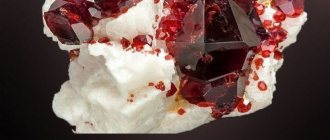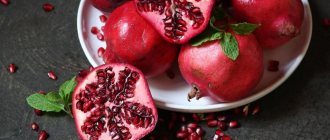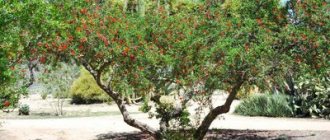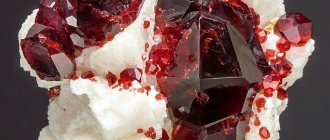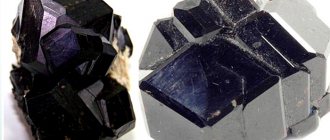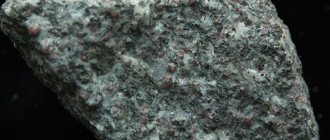Description of the plant
The photo of a homemade pomegranate shows oblong-shaped leaves with sharp tips. The portrait of a native of Asia Minor is complemented by a brown with a light tint with branches; there are thorns on the branches.
The pomegranate flower boasts an unusual shape; there are petals around the red perianth that cover it; their colors vary: scarlet, yellow and white, it all depends on what variety it is.
Varieties of pomegranate
More often, garnet is associated with a dark red stone, a deep, almost burgundy hue. In fact, garnets are a whole family of stones, each of which has its own name, color and distinctive features.
Pyrope
A widely known garnet is blood red in color, sometimes darker to a burgundy-brown hue. It got its name from the Greek word “pyropos”, meaning “fiery”.
Advertising - Continued below
Rhodolite
Rhodolite is a rare, but at the same time amazingly beautiful variety of garnet: dark pink to violet, uniquely shimmers in the light with shades of lilac and crimson.
Andradite
Andradite is a fairly common type of garnet that comes in not only dark burgundy, but also yellow, orange and even green. In fact, andradite is a whole separate subgroup of garnets, which includes green demantoids, black melanites, as well as topazolites, colophonites and jelletites.
Spessartine
Spessartine is a rare unusual type of garnet with brownish-yellow, orange, pink and brown colors. These stones almost always have cloudiness or foreign inclusions, and those that weigh more than 4-5 carats are especially valuable.
Almandine
Almandine is one of the two (along with pyrope) most popular varieties of garnet. It has a juicy cherry-red color, sometimes with a purple tint. One of the first to become famous in Rus'. For its deep, noble color, almandine is often compared to ruby.
Advertising - Continued below
Grossular
Grossular is a pale green or yellow-green garnet. The stone got its name from the Latin word “grossularia”, meaning “gooseberry”. In turn, it has several more varieties, including tsavorite and hessonite.
Nana
The height of this representative is 1 m, it is similar to a garden pomegranate, but its size is much smaller, the leaves are small, and the flowers and fruits are small.
Carthage
The dwarf indoor plant "Pomegranate" of the "Carthage" variety looks like a small tree. At home, it does not grow higher than 80 cm. The foliage of the plant is small, up to 2 cm long.
With flowers about 4 cm in diameter, the plant delights throughout the warm period. The corollas are painted red. The fruits of this pomegranate variety are small, sour, but juicy and have excellent taste.
Uzbekistan
It grows up to 2 m, the variety is taller when compared with the above-mentioned dwarf representatives, its red fruits taste sweet and sour.
You can experiment - try to plant a garden pomegranate by planting a seed of a fruit that is sold on the market. It will not be an exact copy of the copy you liked.
This pomegranate grown indoors will differ from that grown in open ground; it does not produce a rich harvest; it is difficult to find all the parental characteristics: the pomegranates that can be found on sale are hybrids. Planted in the garden, the subtropical shrub rises 5 m; in the room it is much lower - approximately 1 m.
In dwarf ornamental plants, the leaves do not fall off with the onset of cold weather, so they look elegant at any time and resemble a miniature pomegranate.
History of pomegranate
The name pomegranate is similar to the succulent fruit pomegranate, and is believed to come from the Latin words "granatus" or "granum", which mean "pomegranate seed" and simply "seed" respectively.
Advertising - Continued below
Already in the 16th century, people in Russia learned to recognize garnet and even identified several varieties of the mineral, called “venice” and “bechet”. It is worth noting that this was the name given to not very valuable and pure representatives of garnets, because... they were contrasted with expensive and bright spinel and precious ruby.
At the beginning of the 17th century, the scientist Boethius de Boot wrote in an essay on stones that the bloody Bohemian garnet, known in Rus' at that time, was a hardened drop of water, colored with blood vapor.
Flowering and fruit set
Pomegranates bloom for quite a long time - from April to the end of August, the flowers are distinguished by their beauty and unusual shape. There are 2 types of flowers:
- Pitcher-shaped plants have long pistils, from which fruits are subsequently formed.
- Campanulates have short pistils and do not produce fruits.
There are much more flowers of the latter type - 90% of them compared to 10% are fruitful; pomegranate flowers are self-pollinating. Their sizes vary, their diameter is 2 cm, and their length often reaches 4 cm.
If the flower is sterile, it quickly fades; the life of the fruiting plant lasts from 6 to 10 days.
The small fruits of the dwarf pomegranate begin to set in the fall after the flowering period ends. Edible fruits come in a variety of colors, ranging from orange to deep red, they have thin skins, and they are sour.
Pomegranate varieties: photo and description
Let's consider domestic and foreign varieties of pomegranate.
Baby
The Baby variety is the smallest of all those offered for growing at home. The plant form is a bush. Grows no more than 50 cm in height.
A very decorative, beautifully flowering variety of pomegranate. A shrub that partially loses its foliage in the fall during the dormant period. Requires mandatory annual pruning and thinning.
Photo of the Baby variety:
Dwarf Carthage
A plant variety specially designed for home cultivation. A small tree, it is advisable to trim the plant to keep its height no more than 60-70 cm.
If the plant is not trimmed , the branches become thinner, and small growths inside the crown create an untidy, ugly appearance. The plant not only looks worse, but also blooms less often. The appearance of the plant during flowering is simply mesmerizing.
The Carthage variety is not whimsical; it grows and develops well. With sufficient moisture and light, it bears fruit every year.
Photo of dwarf Carthage:
Ahmar
It is believed that the most delicious and sweet fruits come from Iran. Akhmar belongs to the sweet Iranian varieties. The plant reaches a height of 4 meters. It blooms with red-orange flowers, not very elongated. Flowering continues from mid-June to the end of August.
The fruits are medium in size, the skin is pink-green, thick. The grains are light pink. The lighter the grains, the sweeter the fruit . It is believed that Akhmar is one of the first places in terms of sugar content.
The local population appreciates it not only for the taste of the fruit. Thin branches are suitable for weaving baskets; high-quality dye was previously obtained from the flowers. All parts of the plant are used in folk medicine .
Nar-Shirin
The Nar-Shirin variety is similar in description and taste to Akhmar. The skin of ripe fruits is pale. The outside is pink-beige with beige-green splashes. Beige inside.
Nar-Shirin grains are small and round in shape. The color gradually changes from pale pink to dark. The variety is classified as sweet .
Iranian pomegranates most often grow in nature; they began to be cultivated recently , mainly in the central regions. The local population uses wild fruits for food.
Despite their good taste, they are inferior to other varieties, larger and more attractive. Used mainly in the domestic market.
Dholka
The sweetest of all varieties existing in nature . The homeland of the plant is India. Grows in wild plantations. The fruits are light with a pinkish tint. Small sizes. 180 – 220 grams. The grains range from white to light pink. The shrub is small, up to 2 meters tall. Sheet 4-5 cm.
In Indian folk medicine, for fractures, bruises, and to relieve pain, a drug made from pomegranate roots . The standard of living of the common people in India is very low, and unsanitary conditions often lead to various diseases. Indian healers use decoctions of tree bark and roots to treat worms and various forms of dysentery.
Mangulati Sweet
A slightly sour variety from Israel. Pleasant to the taste. Orange-red. Fruit weight is from 150 to 250 grams. The grains are pink-red. In Israel, the pomegranate tree is considered sacred.
This is a symbol of love and divine beauty. Cultivated plants of this variety produce larger fruits up to 400 grams . With good care it can grow up to 5 meters in height.
The Israelis produce pomegranate seed oil. It is widely used in cosmetology. Highly effective preparations for skin rejuvenation are created based on the oil.
Seed oil is a strong antioxidant. Helps lower blood sugar levels. Helps trigger the self-destruction mechanism of breast cancer cells.
Bedana
Another Indian variety. There is little information about Indian varieties; it is only known that it belongs to the group of sweet pomegranates . The fruits are small. Wild plants. Used in the domestic market.
Achikanor (Achik-anor)
Belongs to the sweet and sour group of pomegranates. Mid-season. The fruits are round, slightly narrowed towards the base, red-green in color, the grains are dark, cherry-colored, and large in size. The juice tastes tart and pleasant. It quenches thirst well.
Achik-anar
Another consonant variety, similar in name. The bush of the plant is large, growing more than 4.5 meters in height. The fruits are round. Big ones. The average weight of one fruit is 450 grams . The skin of the fruit is red with green stripes. The grains are large, red.
The taste is sweet, but not cloying. The variety is mid-season. Harvesting begins in the first ten days of October. From one bush you can collect from 40 to 50 kg. fruits The variety was created by Uzbek scientists.
Ak-Dona
The plant is mid-season. The harvest begins in the second half of October. The fruits are slightly flattened, the peel is yellow-pink with red spots of different sizes, thick, and colored bright lemon on the inside. The grains are large, dark pink. They taste sweet.
The plant itself is not very tall, but wide. The leaves are bright green, large 5 - 7 cm. Central Asia is called the homeland of this variety.
Akdona
This pomegranate is also from Central Asia. Because of its very large grains, it was given a second name - Tyuyatish, camel tooth . The fruit has a light skin with a delicate raspberry “blush”. The grains are dark pink, elongated.
It blooms with red-orange elongated flowers. The calyx of the flower has the shape of a cone, with bent edges.
Ak Dona (Crimean)
A zoned variety, bred in the Nikitsky Botanical Garden . The fruits are large and round. With a thick and short neck. The peel is thin and creamy. One side is soft pink, the other has bright spots. The grains are dark pink, sweet with a slightly noticeable sourness.
Photo of growing Ak Don:
The more you get acquainted with different varieties of pomegranate, the more you want to grow them at home. Any variety of pomegranate can be grown on your windowsill.
Plant a pomegranate seed you like in the ground, and after a while it will sprout. But it is still better to use special varieties for home cultivation.



